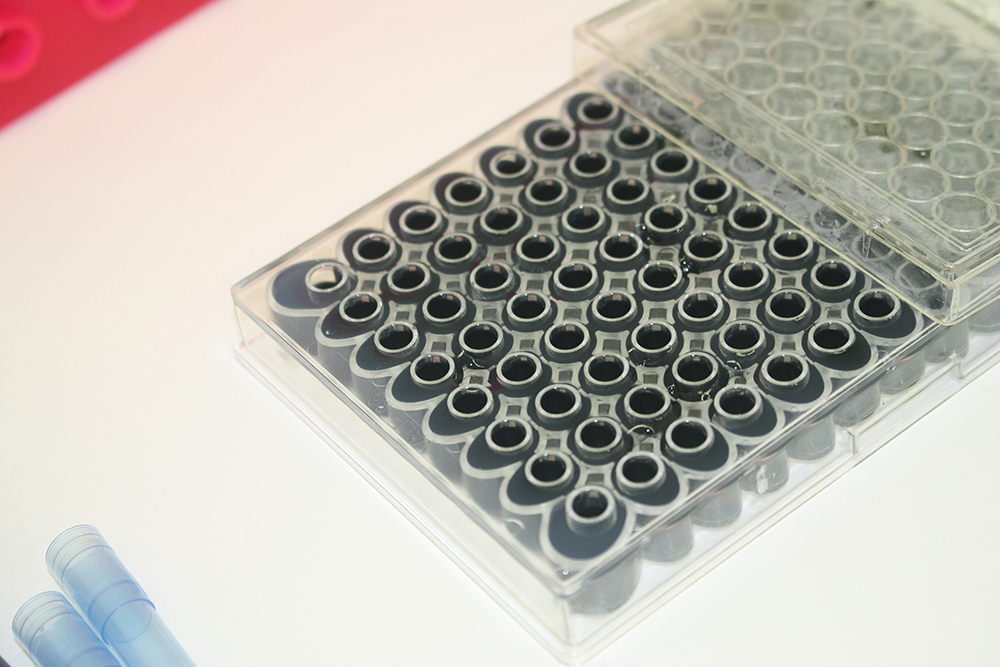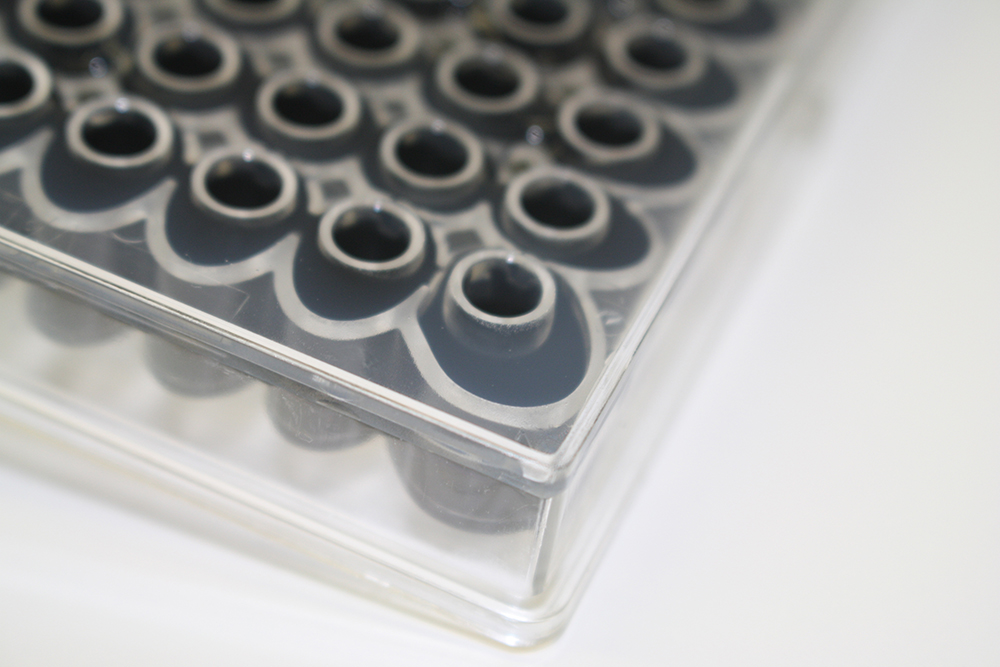
The BioClime+™ 96 – Gel Microplate

Say goodbye to edge effects and hello to effective miniaturisation
Developed in collaboration with academic and pharmaceutical institutions and trialled and approved by major research organisations.
| Enhanced thermal retention | + | Reduced evaporation | + | Improved CO2 stabilization | = | Improved reproducibility, cell growth and viability |
|---|
Advantages
- Improved reproducibility and cell growth
- Better data quality
- More uniform results & fewer repeats
- Shorter development time
- Considerable cost savings

Features
- Space saving
- Cost effective
- Lower reagent consumption
- Increased sensitivity
- Higher throughput
Design
- Engineered to eliminate edge effects
- Unparalled microwell environment protection
- Low volume range (10nl to 150mL)
- No filling of moats or interwell spaces
- Solid state environmental buffering technology
- Protects cells against Evaporation and fluctuations in Temperature and pH
- Compatible for high resolution microscopy (63X using High NA water immersion lens
Video User Guides, Product Information Sheets & More
Journal Articles
FAQs
What are the advantages of BioClime+™ 96 Microplates?
They save time and money and improve the reproducibility of experiments because of their specific design. The BioClime+™ 96 was developed to provide a simple and effective, 96-well microplate that saves eliminates edge effects and saves time and money and improves the reproducibility of experiments.
How do BioClime+™ 96 Microplates improve reproducibility in my experiments?
BioClime+™96 Microplates have been engineered to eliminate edge-effect, the patented design features a solid-state environmental buffering technology that provides unprecedented well-to-well protection against fluctuations in multiple environmental factors.
What are edge effects?
The “edge effect” is a discrepancy between the inner and outer wells (local environment), where each well has it’s own unique environment. Edge effects are commonly seen in high density formats as well volumes decrease as density increases.
Environmental edge effects can lead to variation across microplates, compromising the efficacy, reproducibility and reliability of cell-based assays. Fluctuations in environmental conditions, such as temperature and CO2 concentration, can trigger a variety of unwanted cellular responses and result in the evaporation of culture medium from the perimeter wells. Consequently, the micro-environment of the outer wells varies considerably from that of the inner ones, altering cell viability and assays results
How do BioClime+™ 96 Microplates work?
A: When placed in the incubator the buffering gel absorbs heat, CO2 and the vapor pressure of water reaches equilibrium with that of the incubator atmosphere. When the incubator door is opened, or the plate is removed from the controlled environment, the Buffering Gel releases heat, water and CO2 down their respective gradients counteracting environmental changes within the microplate.
What is the BioClime+™ 96 environmental buffering system (EBS) made of?
The environmental buffering system is a no toxic hydrogel containing substances to enhance the absorption and release of heat and atmospheric gasses.
What is the surface area of the BioClime™+ 96 Microplate wells?
Do I need to use BioClime+™ 96 Microplates differently from standard microplates?
No, you can use BioClime+™ 96 Microplates in exactly the same way as standard microplates.
Can I use BioClime+™ 96 Microplates for live cell imaging?
Yes BioClime+™ 96 Microplates have been developed to improve the quality and reproducibility of live cell experiments.
Can I perform imaging experiments in these microplates?
Yes, these plates have been developed for use with microscopes and automated imaging systems. BioClime+™ 96 Microplates have been used successfully using high NA Water immersion objectives Water Objective 63x.
Are BioClime™+ 96 microplates compatible with imaging instruments such as confocal microscopes and high content analysis?
Yes, these plates have been developed for use with microscopes and automated imaging systems. BioClime+™ 96 Microplates have been used successfully using high NA Water immersion objectives Water Objective 63x.
Are BioClime+™ 96 Microplates compatible for use with fluorescent and luminescence plate readers?
BioClime+™ 96 Microplates are constructed from high quality, transparent, polystyrene and can be used for both top and bottom read over a wide range of visible light wave lengths (derived from either fluorescence or luminescence).
How do I store BioClime+™ 96 Microplates?
BioClime+™ 96 Microplates are best stored at room temperature in dry, dark conditions. We recommend that you do not store BioClime+™ 96 in direct sunlight.
How do I prepare BioClime+™ 96 Microplates before use?
BioClime+™ 96 Microplates can either be used directly at room temperature or pre-warmed in an incubator prior to adding cells.
How long do BioClime+™ 96 Microplates protective effects last when used?
This depends on experimental and maintenance conditions. However, we have developed BioClime+™ 96 Microplates to maintain function for 28 days when maintained at 37°C 5% CO2 >95% (Relative Humidity). Obviously, the actual length of time depends on experimental and maintenance conditions.
What volume of media/ cell suspension should I add to these microplates?
Depending your experimental requirements volumes ranging from 10nl to 150µL can be used.
What is the surface area of BioClime+™ 96 Microplates wells?
Are BioClime+™ 96 Microplates compatible with imaging instruments such as confocal microscopes and high content analysers?
Are BioClime+™ 96 Microplates automation compatible?
Yes, these plates have been developed for use with all classes of automated plate and liquid handling technologies.
What surface treatments are available?
BioClime+™ 96 Microplates are currently available in both tissue culture treated and low attachment surfaces.
Are BioClime+™ 96 Microplates expensive?
BioClime+™96 Microplates cost about the same as other commercially high-performance microplates.
